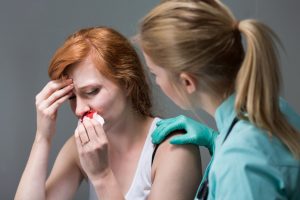Von Willebrand Disease: the Under-the-Radar Bleeding Disorder
Constant nosebleeds, persistent bruising and super-heavy periods are signs you shouldn’t dismiss.
By Lisa Esposito | Staff Writer Oct. 7, 2016, at 10:03 a.m.
Von Willebrand Disease: the Under-the-Radar Bleeding Disorder
This common bleeding disorder affects up to 1 percent of the U.S. population. (GETTY IMAGES)
You’ve probably heard of hemophilia – with its history among European royalty – but maybe not about von Willebrand disease, the much more common bleeding disorder affecting up to 1 percent of the U.S. population. In von Willebrand disease, named after the Finnish scientist who discovered it, the blood is missing a key protein that helps it clot. Many people don’t realize they have the genetic condition until a severe bleeding episode leads them to a hematologist, a doctor who specializes in blood disorders.
In August, Alexandra Schultz, 19, a student at Southern Utah University, finally received a von Willebrand diagnosis after years of heavy menstrual bleeding and too-easy bruising. Fortunately, Schultz has von Willebrand Type 1, the most common and mild form. Type 2 and Type 3 are also genetic forms, while acquired Von WIllebrand may be a result of certain other conditions, such as lupus or heart disease.
“I’ve always had super, super-heavy and irregular periods since I was 11 or 12, when I started having my period. I was always wearing a pad and a tampon even to feel comfortable going to school.” Recently, she found herself in her home hallway, feeling something was wrong: “I looked down, and I was just standing in a puddle of blood.”
Since connecting with a specialist and starting treatment, Schultz has quickly educated herself on the condition and already seen an improvement.
Dr. Catherine Broome, an associate professor of medicine with MedStar Georgetown University Hospital in the District of Columbia, who also specializes in hematology/oncology at the Lombardi Comprehensive Cancer Center, compares the bleeding disorders.
“Hemophilia is a disease of proteins that are responsible for generating a substance called fibrin, which is part of a clot,” Broome explains. “Von Willebrand factor is a protein that augments or enables your platelets, which are cells in your blood that help to form a clot, to stick together. So they both result in bleeding but it’s a very different kind of a mechanism.”
With von Willebrand disease, Broome says, the bleeding patterns tend to be on mucosal surfaces. So in addition to frequent nosebleeds, people may have bleeding gums when they brush their teeth or bleeding in their gastrointestinal tract. Generally, she says, people have bleeding from more than one site.
“Platelets are responsible for keeping us from bruising,” Broome says. “And if they’re not working well because of a lack of this von Willebrand protein, people may develop easy, frequent, unexplained bruises.”
People with severe, untreated von Willebrand disease may have spontaneous bleeding into their muscles or joints, which can do lasting damage to the lining of the joints and cartilage surrounding the bone, similar to arthritis. “Once the diagnosis is made, we can design a treatment program that will minimize those risks,” Broome says.
Monthly Distress
Heavy, long-lasting menstrual periods are hallmarks for women and girls with von Willebrand disease. A family doctor or a woman’s OB-GYN may recognize a problem and refer the patient to a hematologist. But oftentimes, people don’t realize what they’re going through isn’t normal. They may become pregnant without realizing their delivery could put them at risk.
“A lot of times families may not even talk about it,” Broome says. “We see patients all the time, when you finally do get the diagnosis and you start looking back at the family: ‘Oh, yeah, my mom almost bled to death when she had my brother.’ Sometimes people don’t connect the dots. It’s better if you have any questions or concerns about bleeding that you get yourself evaluated.”
Women with von Willebrand disease who plan to become pregnant should consult a hematologist and an obstetrician who specializes in high-risk pregnancies, the National Heart, Lung, and Blood Institute advises. You may want to use a center that specializes in high-risk pregnancies and has a bleeding-disorders specialist on staff.
Men, Too
Men and women are at equal risk for von Willebrand disease. If a parent has it, Broome says, infants should be tested at birth. “You would want to know. Especially for little boys – you wouldn’t want to circumcise them if you didn’t know they had a bleeding disorder.”
Knowing the diagnosis is key for everyone, Broome says. “If you don’t know, you could suffer grave complications from bleeding,” she says. “If you do know, we can prepare you if you need to have surgery. We can make it very safe.”
The goal is for people to maintain as normal a lifestyle as possible. “We have young men and young women who play all manner of contact sports,” Broome says. “If they have mild or moderate disease it’s generally not an issue. If they have severe disease they may require some factor replacement on days prior to their activities.”
Restoring Missing ‘Factor’
Factor replacement involves infusion of intravenous medications containing von Willebrand factor. These infusions are plasma-based concentrates (plasma is the liquid component of blood). Brands approved for von Willebrand in the U.S. are Alphanate, Humate P and Wilate.
Medication improves the body’s ability to clot blood and prevent and treat bleeding episodes. Treatments can boost the release von Willebrand factor from the body’s cells, or replace the missing factor with intravenous concentrates that contain it.
For milder forms, a medication called desmopressin acetate, or DDAVP, stimulates the body to release von Willebrand factor. Patients usually take DDAVP by nasal spray or injection.
Patients with more severe disease forms receive factor replacement therapy at regular intervals, or before invasive medical procedures.
Oral medications such as Amicar and Lysteda help some patients. “They’re not exactly replacements for von Willebrand factor but they help to stabilize the blood clot once it forms so that bleeding will stop,” Broome says.
With replacement therapy in particular, cost is a big concern. “Clotting factor is very expensive,” Broome says. “It can create a significant financial burden for patients and/or families if their insurance is not good. A variety of organizations do offer some help to try to defray costs of copays and other medications.”
Costs vary widely depending on the patient’s type of disease and medications needed. “It could be as low as $10,000 a year for someone with a mild type of VWD to more than $100,000 for someone with a severe form of the disease,” Michelle Rice, senior vice president of public policy and stakeholder relations with the National Hemophilia Foundation, wrote in an email.
“[We are] working with the payers and trying to get insurance companies to understand what it’s like to live with a bleeding disorder, and why consumers and patients need [these drugs] and why they might need a particular product versus another one,” says Kate Nammacher, director of education with NHF.
Spreading the Word
Patients are advised to wear medical alert bracelets, Broome says: “Certainly, an accident would be a time when we would want first responders to know very quickly that you have a bleeding problem.”
Schultz uses the medical ID on her iPhone, which lists her diagnosis and prescriptions. Her medication is the DDVAP nasal spray and she hasn’t noticed any side effects. “If anything, if I’m bleeding and I take that, within hours I can feel and notice a difference,” she says. “It’s pretty amazing.”
You can learn more about the disease through the NHF’s Better You Know Campaign. Women can use the risk-assessment tool on the website by entering their bleeding symptoms to figure out if they might be at risk for a bleeding disorder. (The men’s risk-assessment tool is still being developed.)
Source:
http://health.usnews.com/health-news/patient-advice/articles/2016-10-07/von-willebrand-disease-the-under-the-radar-bleeding-disorder


